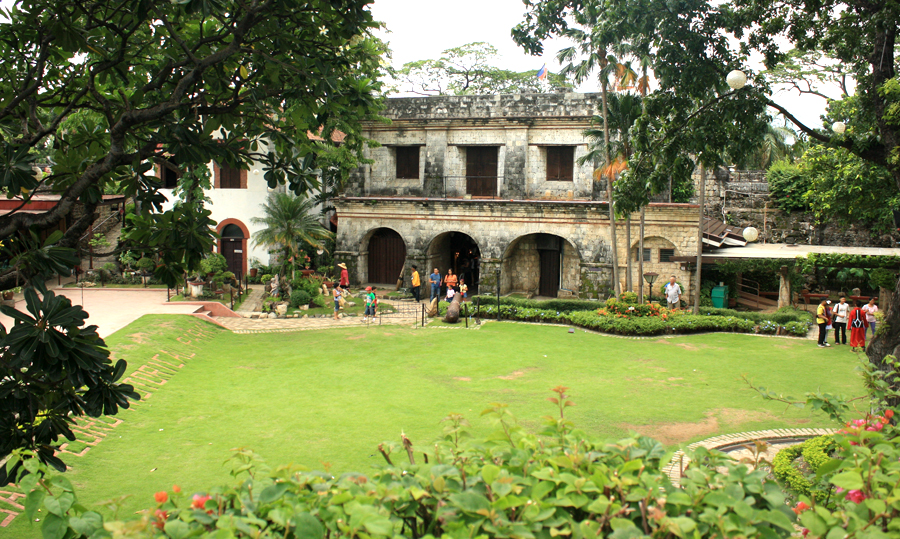Some 45 years after Chieftain Lapu-Lapu killed Portuguese explorer Ferdinand Magellan on the shores of Mactan, a Spanish group led by Miguel Lopez de Legazpi came back to Cebu and set up the first Spanish settlement in the Philippines known as Villa San Miguel. The nucleus of this settlement is Fort San Pedro, which was commissioned by de Legazpi in 1565 but completed only in the 1700.
Contrary to popular belief, the Sugbuanons (Cebuanos) were not friendly to the invaders but did not use violence to fight them. They resisted the Spaniards by not giving or selling them food.
My friend Ruel Javier Rigor, a museum curator and tourism professor, said while this information is rarely found in history books, it was indeed the passive resistance of Cebuanos that led the Spaniards to leave the island to search for food, water, and other supplies.
Rigor said the fort used to have wooden curtain walls and slits that were for cannons or arrows.
My memories of Fort San Pedro dates back to pre-school days when our mom would pack us simple snacks of bread and juice and bring us to the park beside the fort.
I remember it being like a castle straight from the fairytale books yet without the moat, or that ditch with steep sides filled with water, and crocodiles.
Neither has it the usual turrets (those steeples on the roof that look like upside down ice cream cones) from the pages of Cinderella or Snow White.
Through the years growing up, schools required us to visit the fortress. Those were times spent giggling and running along its walkways with classmates.
There was also one December night a couple of years back when I went inside the fort to celebrate the wedding of a grade school friend Ysolde Alburo Collantes to William Jatulan. That night, the trees and subdued lights lent a romantic air to the event.
Recently, Marlen and I with her two boys revisited this small triangular fort that used to be right beside the Cebu shoreline. Now as tita to these bright, impressionable boys, the fort through their eyes transformed into a vast playground with hide and seek possibilities. They were so amazed at everything, too: the well and how it supplied the settlers with their own water, the tisa roof, the stone walkways, the doors, even how the Spaniards looked, especially the famous Magellan.
The fort, named after Legazpi’s flagship San Pedro, is the smallest and oldest fort in the country and protected the island from Moro raiders. It started as a single triangular bastion when it was first built with logs and mud in 1565 but was described in a 1739 report to the King of Spain as triangular in shape, made of stone and mortar, and with three bastions named La Concepcion, (southwest side), Ignacio de Loyola (southeast), and San Miguel (northeast).
It was also the center of the first Spanish community known as Villa San Miguel. The Sugbuanons did not befriend the Spaniards when they arrived but also did not shoo them away or stone the fortress or build traps for the invaders. Neither did they set the settlement on fire. They just denied food and other basic needs to the Spaniards.
Out of hunger, the Spaniards left for Panay island in Luzon. They left Villa San Miguel with only a few guards to man the fort as an outpost. In 1569, the Spanish group defeated Rajah Soliman of Manila, where the Spaniards built Intramuros. Shortly after, they came back to strengten their hold in Cebu.
Centuries later, the fort of over 2,000-square meters with walls 20 feet high and eight feet thick became a meeting place for local revolutionaries.
By the start of the 20th century, it was witness to the coming of the Americans who made the fort their barracks. Almost half a century after (1941-1945), the Japanese came and also made it their camp.
Indeed, with towers of 30 feet high, the fort has served its varied inhabitants well.
During the American period, some rooms became classrooms. By mid 1950s, the Cebu Garden Club transformed the inner court into a miniature garden. Years after, the fort housed animals from the city zoo.
By 1978 to 1993, the Department of Tourism and Philippine Tourism Authority held offices inside its cool structures.
At present, the fort, as a historical park, falls under the administration of the National Museum.
A museum inside the fort houses artifacts from the old Spanish Galleon San Diego, a trading ship converted into a warship which sank a short distance away from Fortune Island, Nasugbu.
Today, the fort may no longer be capable of withstanding outside forces, what with its size and the growing number entry points to the city not to mention the increasing population. It, however, remains important to the Cebuanos. It will always be an integral part of the city’s rich cultural heritage.
For my generation and those after mine, the fort is a childhood playground, sweet and dear, safe and sturdy. Its walls and citadels gave birth to dreams only kids with a fort for a playground can concoct.
The fort opens doors 8am to 7 pm daily with P30 entrance fee for adults and P20 for students.
How to get there
The easiest way to get there if you’re taking public transport is by riding a taxi. All cab drivers know where it is. From the uptown area, it’s a 70 pesos taxi ride. If you’re taking the cab from Lapu-Lapu City, the ride may cost you 180 pesos.
If you want to go there Pinoy style, take the Philippine icon of mass transportation, the jeepney. Several jeepneys have routes that pass the place. Look for jeepneys with Pier 2 or Plaza signboards in their windshields.

